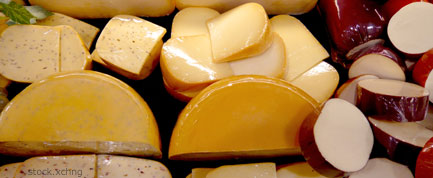The Strange History of Cheese

For many, the mild, slightly nutty flavor of Gruyère is the perfect addition to a steaming bowl of French onion soup or a ham sandwich, but for the medieval peasants who first created it, the flavor was secondary to matters of survival and location.
Gruyère resulted from the historic collision of food scarcity and a mountainous geography, yielding a distinct and rigorous cheese-making process.
In fact, all cheese types—there are now more than 1,400--initially arose due to the unique constraints forced by geography and the human effort to preserve the valuable commodity that is milk, says food scientist Paul Kindstedt, of the University of Vermont.
Cheese recipes initially arose as a way to preserve the nutritional value in milk for longer periods of time, so the number of types primarily reflects the number of struggling pre-industrial communities that successfully devised a method to achieve this given their local climate, resources and terrain.
At a recent lecture at the New York Academy of Sciences in Manhattan, Kindstedt, of the University of Vermont, elaborated:
“Traditional cheeses always originated because cheese makers had to adapt to the cultural and environmental constraints of their local world,” he said. “And they had to do things differently from one region to the next, because cheese makers in different regions face different constraints.”
His lecture detailed the cheese making process and and the new work he is doing to reveal the history of cheese-making practices and how it was shaped by what he calls the universal scientific principles of cheese.
Sign up for the Live Science daily newsletter now
Get the world’s most fascinating discoveries delivered straight to your inbox.
What is cheese?
Those principles derive from the unusual properties of milk, cheese’s primary ingredient.
“Whether you’re talking about milk from a cow, goat, sheep, water buffalo, camel, yak or any other mammal thats milk is used for cheese-making, all milk contains five basic components,” Kindstedt said.
Those components are water, lactose (or “milk sugar”), fat, protein and minerals.
The protein in milk is of two types: casein and whey. Along with fat, casein makes up the bulk of the solid part of cheese, while whey is essentially the liquid left after the milk curdles.
Some of casein’s amino acid chains strongly bind the mineral calcium phosphate (the main component of bones and teeth), which holds casein molecules together in larger spheres called micelles.
The surface of the micelles is hydrophilic, or water-loving (this is why milk is white—the surface keeps the casein suspended in water).
How cheese is made
Eight steps have made up the cheese making process for every cheese since they were first made, and those steps have three objectives: to expel water, to de-mineralize the casein with bacterial acids, and to add salt.
The exact target for each objective is different for each type of cheese. Each has its own target water content, acid content and salt content—all of these things affect the cheese’s ripening process and which microbes flourish with in it, ultimately influencing its final aroma, texture and flavor.
“So you’ve got to get these three parameters right, or the newly-made cheese, which starts out very curdy, very uninspiring, very bland, will never ripen into what it’s intended to be,” Kindstedt said.
Step 1—Setting: Bacteria (either already swimming around in the milk or added to it) and enzymes derived from the stomach linings of milk-producing mammals and called rennet are added to the milk. The rennet shaves off the hydrophilic surface layer of the casein, causing the micelles to coagulate into what is called the curd.
For the rest of the eight steps, squeezing out the water, or liquid whey, from the cheese is a major goal, depending on the type of cheese. For example, cheddar cheese starts with a moisture content of 87 percent and that has to be reduced down to 37 percent, while brie retains more of its whey.
Step 2—Cutting: The curd is “cut” into smaller particles—the smaller the particle, the less water it holds, thus more whey is expelled from the curd. (So drier cheeses like cheddar will be cut into smaller particles than moister cheeses like brie.)
Step 3—Cooking: The curd is heated and stirred, which expels more whey.
“For some cheeses like Parmigiano Reggiano, they’re cooked to very high temperatures with considerable stirring for long periods of time,” Kindstedt said. “At the other extreme, some cheeses like brie, traditional brie, receive essentially no heating, no stirring, no cooking.”
Step 4—Draining: Draining separates more whey from the curd, depending on how dry the final cheese is supposed to be.
Step 5—Knitting: This step overlaps with draining; as the whey drains away, the curd particles come into contact with each other and stick into a bigger mass.
Step 6—Pressing: Weight is applied to the cheese to give it its final shape and to squeeze out more whey, depending on the type of cheese of course.
Step 7—Salting: Salt can be added by sprinkling or rubbing it on the cheese or by submerging the cheese in a salt brine; it continues to draw out whey.
Step 8—Special applications: These can include applying specific environmental conditions such as humidity and temperature or physical manipulations like turning the cheese while it ages.
The story of Gruyère
So what about Gruyère—just how did its creators come to create this unique cheese? In the Middle Ages, the peasants in small feudal villages in the Gruyère region of eastern Switzerland began to use grassy meadows in the mountains to graze their cattle.
But since it was impractical, not to mention tiring, for each peasant to march uphill every day to milk their cows, a few peasants were appointed to watch the whole village’s herd, milk the cows, and make cheese from the milk every day.
Because the cheese would have to be kept in the mountains until the end of the summer, it had to be long-lived; and to make the unsteady trip down the mountain, it had to be large and durable so as to avoiding chipping and cracking.
“The cheese was deliberately built to last, so to speak,” Kindstedt said.
But “in order to make the cheese long-lived, large and durable, it had to be low in moisture content,” he added. “The cardinal rule of cheese: the higher the moisture content, the shorter the shelf life.”
The peasants had to use fresh milk every day, Kindstedt has surmised, which meant there was a higher moisture content as the cheese developed’ and they could only haul so much salt up the mountain with them at the beginning of the summer, so they had to use it sparingly.
To get around these limitations, Gruyère makers created an elaborate cutting technique “that was designed to produce a very small, pea-sized curd particle” to expel water, Kindstedt said.
They also cooked and stirred the cheese at extremely high temperatures and for long periods of time to squeeze more water out—not an easy process in those times.
“It’s hot, it’s physically demanding, if not downright exhausting,” Kindstedt said. “It’s not something cheese makers would have developed or chosen to do unless they had a real incentive to do it this way, or unless they had no choice,” which was the case for the Gruyère makers and is the reason Gruyère even exists.
In other words, whatever cheese you happen to enjoy munching, be it Gruyère, asiago or muenster, “you can be certain that there’s a good reason that that cheese originated in history when it did and where it did,” Kindstedt said.
- Nutrition Quiz
- Would You Drink Milk from a Cloned Cow?
- Why is Cow's Milk White?

Andrea Thompson is an associate editor at Scientific American, where she covers sustainability, energy and the environment. Prior to that, she was a senior writer covering climate science at Climate Central and a reporter and editor at Live Science, where she primarily covered Earth science and the environment. She holds a graduate degree in science health and environmental reporting from New York University, as well as a bachelor of science and and masters of science in atmospheric chemistry from the Georgia Institute of Technology.










